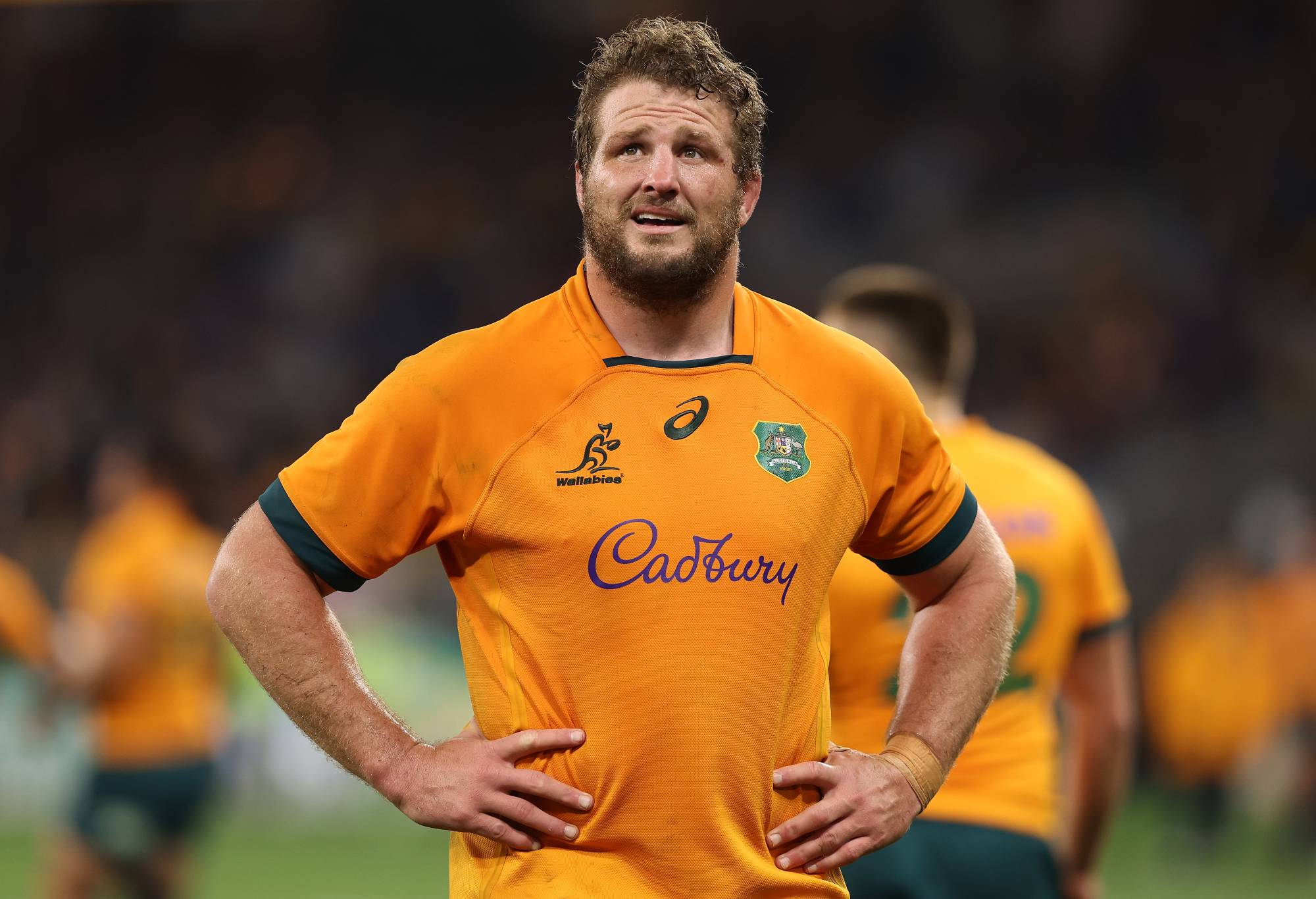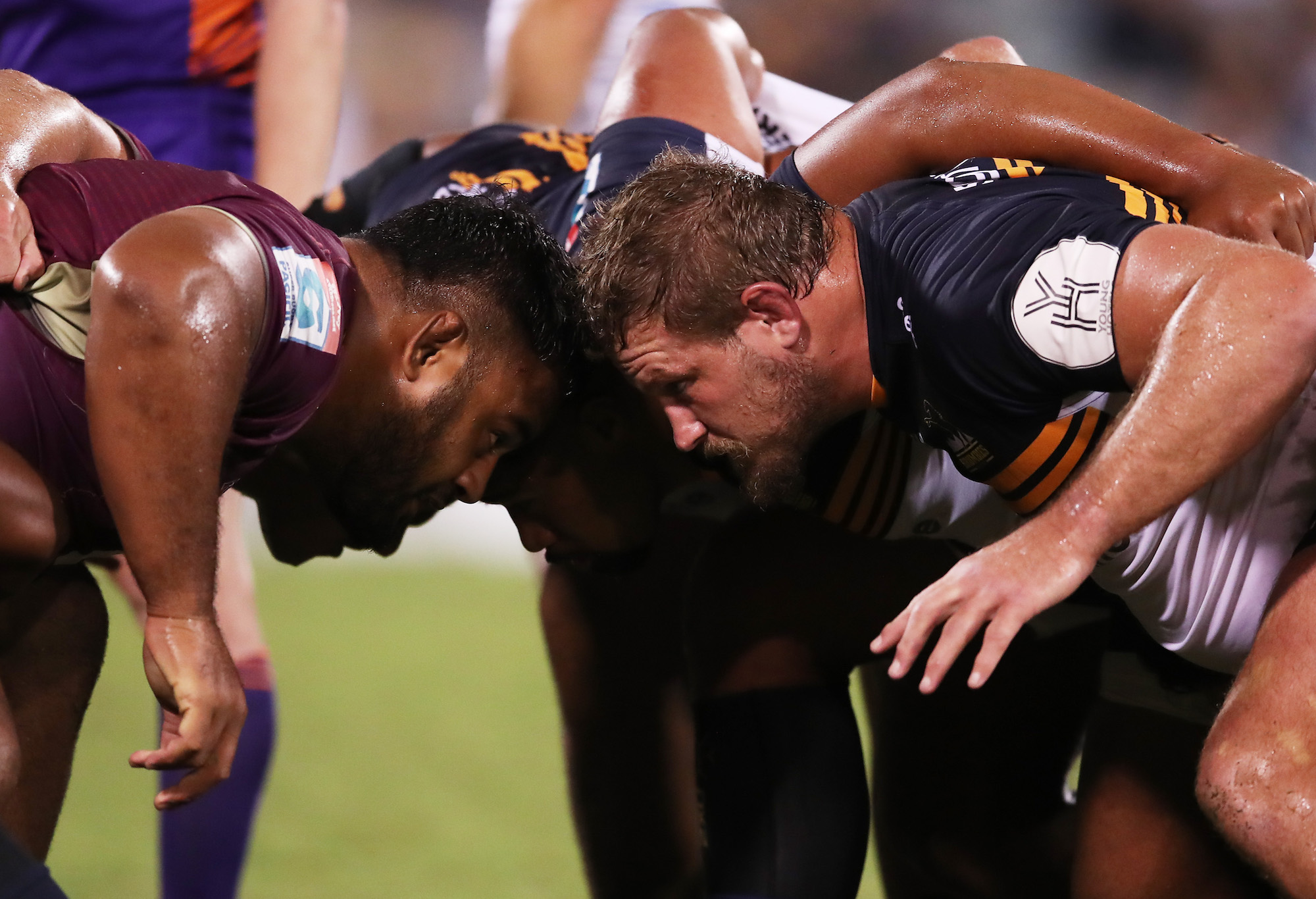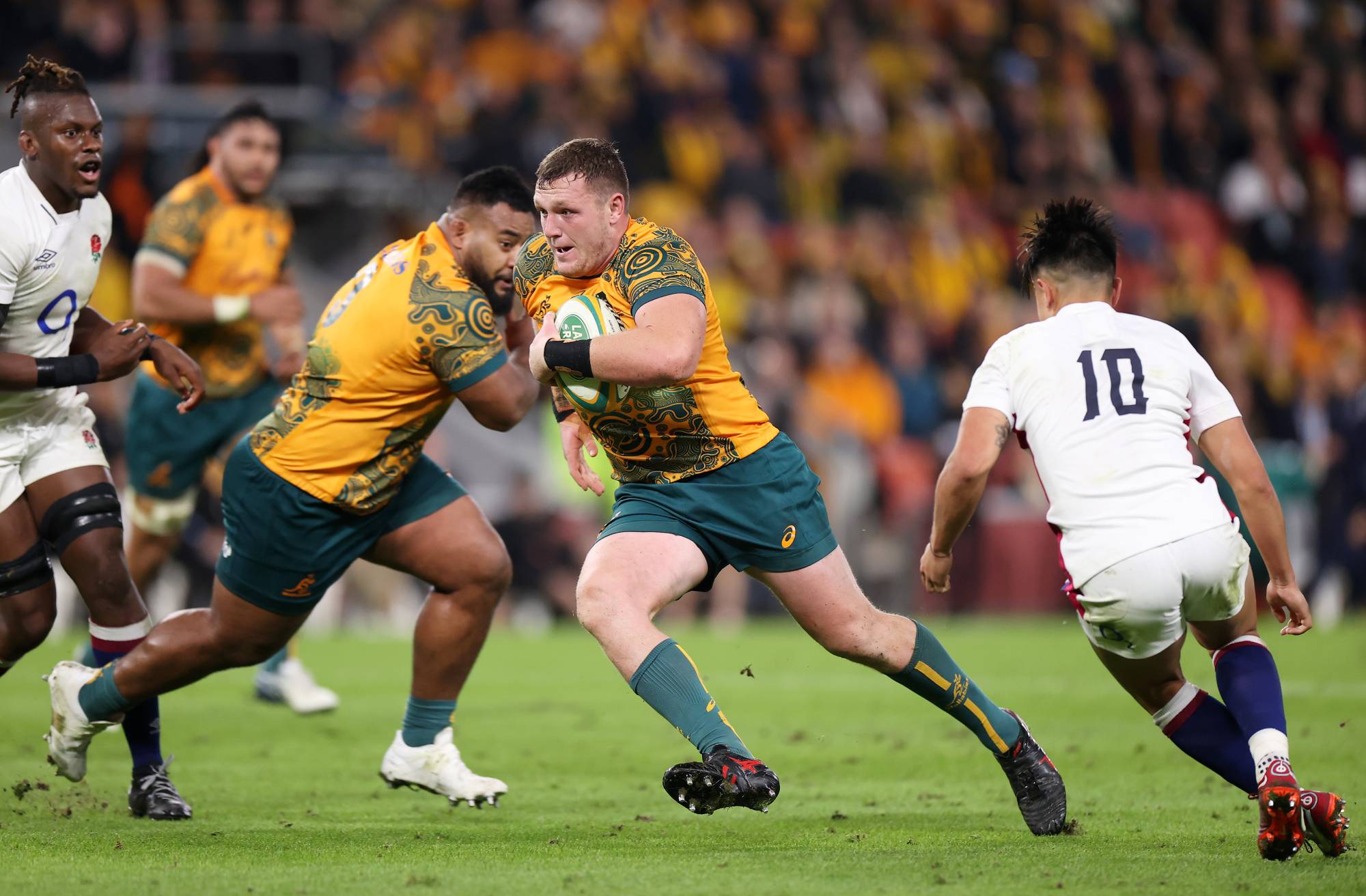If rugby was played between kennel clubs and breeds were required, my team would be (1-15):
Mastiff, Bulldog, St. Bernard, Great Dane, Irish Wolfhound, Rottweiler, Rhodesian Ridgeback, German Shepherd, Jack Russell (captain, because he speaks humanish), Border Collie, Greyhound, Weimaraner, Dalmatian, Vizsla, Malinois.
My bench: all mongrels. My coach? A New Zealand Huntaway. The referee would be a cat.
The pack, as in life, is more valuable and lovable than the backs, but who wouldn’t love to see the Weimaraner take an inside line and the Collie skip pass to the Dalmatian, offloading to the Vizsla?
Why is a loosehead a mastiff?
A mastiff is old. They have been around for two thousand years.
All looseheads are old. Wallaby skipper James Slipper was old when he was young. In the best way. Steven Kitshoff looks like a forty-something Galway bookie who also collects door to door with his tattooed mates Andrew Porter and Cian Healy, both of whom look at home in 1990.

James Slipper (Photo by Paul Kane/Getty Images)
But if I were directing that film, Porter would be a closet empath and Healy the shy enforcer.
Time passes slower at sea level than in high elevation. Time in a scrum stops time. The clock is often turned off. It is an excellent time to go get a meat pie.
Scrummaging at high altitude – that is why High Veldt hero Os du Randt looks like he was born before the Boer War.
Cyril Baille looks like a character on the docks in a Fifties film: no matter how much colour you add to your screen, he’s still in black and white.
Nobody ever saw Beast Mtawarira’s birth certificate but it was rumoured he created the Victoria Falls.

Tendai Mtawarira (C) was a key cog in the Springboks’ World Cup win in 2019. Photo David Rogers/Getty Images
When we say mastiff, I mean the classic mastiff. In a 1590 court document, a deed of sale for “one masty dogge” leads us to understand “masty” meant powerful.
A guard dog. A sentinel. Ninety kilograms (or a hundred twenty in dog years) and 76 centimetres (1.76 meters in human). Small thick ears. Tapered legs. Straight forelegs, set firmly apart. Large round feet with good arches. An extraordinarily thick neck.
The French have their own mastiff, smaller, but fearless, hunting boar. Come to think of it, Baille does look a little like he just ate a boar, at all times.
The bull mastiff has catlike feet, like Slipper, and a wide deep chest like Porter.
The full-lipped puma-hunting Argentinian mastiff is the great drooler of the dog kingdom: Marcos Ayerza would have chimichurri steak in his pockets.
But all the mastiffs are looseheads. A loosehead mastiff is more mobile than a St. Bernard tighthead and has more duties (The Furlong Exception duly noted). Carry they must, and often are the maul callers: staying off the first wave, charged with finding the second stop slot.
A loosehead prop is often a captain, because unlike a tighthead, he talks. Also, he is in the gnostic scrum but also outside of it, wanting to shirk it, eager to peel out.
Tom Smith, the great Scottish and Lions prop, was so mobile and sure handed, he was an extra flank. He did not seem big enough to handle the mountain dogs but did.
In that sense he embodies the perfect paragraph by Jean-Pierre Bodis about rugby: “Strange, singular, complex and undoubtedly perverse in its inextricable and existential mix of violence and intelligence, power and shrewdness, of the exercise of force and mystery of technique.”
A loosehead is part of that great rugby mission: to stop you from playing. A destructive number one can render scrums worse than useless: each one a potential three, or a kick to the corner.
Dan Cole is a tighthead’s tighthead, but in the 2019 World Cup final, he was a Goya painting, impaled by the loosehead, his grimace a wry smile. He had been done by the Beast.
The scrum is the least understood part of rugby. There are fewer of them in top tier matches now, but of those, more result in penalties than ever. The consequence is drama. Unlike a well-run lineout, where an accurate throw to the Great Dane at peak leap by the smiling Bulldog is nearly impregnable, being awarded a scrum one point up in your half to close out a match is heart in mouth.
The second century Gnostic heresy posited cosmological dualism, strict asceticism, repudiation of material creation as evil, docetism, and the existence of the divine spark in humans. If you can understand that you comprehend the scrum.
Yet slim hipped terrier referees stand at the side, swinging their whistle, peering into the abyss, looking for the divine spark to ping.
“Hinging” is their favourite guess. “Scrumming around” is also a hit. “Too far” or “changed bind” are the esoteric doctrines used when they blow by mistake. Part psychology (“why would an attacking scrum want to wheel?”) and part divining (“who has the dominant scrum?”); this realm of the game is inaccessible to the average fan. Only the wise, the former mastiffs, may know.
The ability to understand something before it is observed is at the heart of scientific thought. Copernicus knew the Earth revolves before astronauts had seen it. Einstein knew time was relative before clocks became precise enough to measure the differences. Looseheads can smell how a scrum will go. He has the advantage on the bind.
A loosehead has things loose in his head. He is bound by the strongest man on the pitch; the only one who can bench more than him. It can drive a prop mad. Thus, he is the first to be substituted.

Wallabies and Brumbies loosehead prop James Slipper (R) packs down in the scrum. Photo Matt King/Getty Images
They do not always start out as the heaviest boys in under eights, and many times at junior level they are quite short. They tend to act as fourth loose forwards: A more powerful and slower version of a hooker or flank. But as high school and club demands rise, looseheads tend to be exceptionally strong, able to dominate foes, and at the professional level, have the highest volume of strength work for their team, which requires high fitness levels to ensure quick recovery.
The ones who succeed have good body position, binding and lifting technique and are hallmarked by work rate, ruck cleaning, and hard yards.
In the two prior positional articles (tighthead and hooker) we noticed how those specialty players had grown steadily over the last three or four decades. Not so the loosehead. They have had waves.
Our first cohort was shorter than most props now, but of course, stocky:
Sir Wilson Whineray 1.83 m 96 kg
Tom Smith 1.78 m 103 kg
Jason Leonard 1.78 m 111 kg
Pontypool Price was an engineer and that is how he approached the scrum. Super Kiwi captain Whineray was as smart a player as ever played, with a Harvard MBA, chairs and directorships galore, and knighted. Leonard has led the Lions and the RFU.
As scrums evolved to have a bigger “hit” the looseheads bulked up:
Os du Randt 1.90 m 135 kg
Andrew Sheridan 1.95 m 128 kg
Tony Woodcock 1.84 m 120 kg
It was when my genuine Os jersey became too tight that I bequeathed it to Geoff Parkes and lost 12 kg, last year. But that also taught me he did not actually have a spare tyre with his barrel chest.
Sheridan was too tall to lift and too heavy to be lifted. Woodcock was a weapon for the All Blacks.
Longevity at loosehead started to take a more uniform size in the last decade:
Gethin Jenkins 1.88 m 121 kg
Marcos Ayerza 1.85 m 119 kg
Beast Mtawarira 1.88 m 120 kg
Ayerza played 246 matches for the Leicester Tigers, 66 times for Los Pumas, plays piano and polo, and trains racehorses. Mtawarira played about 300 first class games, but two stand out: the first Test against the Lions in 2009 when he dominated Phil Vickery, and his destructive tour de force in the 2019 World Cup final. Jenkins dominated an entire era for Wales in the front row.
There are still very fine looseheads who are ‘normal’ sized humans, or at least if you hang around big boys:
James Slipper 1.85 m 117 kg
Cian Healy 1.85 m 117 kg
Steven Kitshoff 1.83 m 120 kg
Last year’s skipper Slipper is running smoothly; scoring two tries in a game this year and also slipping offloads for try assists. Perhaps he should have a rest, soon, as the Brumbies are schooning nicely but the Wallabies need him to have a dry sail.
Healy is winding down the clock on his career. Kitshoff captains his club superbly and is quietly one of the three or four best in the position.
So now, we seem to have two types of looseheads, again.
The svelte:
Andrew Porter 1.85 m 119 kg
Cyril Baille 1.82 m 117 kg
Pierre Schoeman 1.84 m 118 kg
Ellis Genge 1.86 m 118 kg
Porter squats 350 kg and was for many years a tighthead. He explains the difference: “hitting a scrum at tighthead is like your safety bar squat while at loosehead it’s more like a single-leg split squat or a Bulgarian split squat. It’s definitely less taxing on the body. About 60 percent pressure is going through your tighthead and 40 percent through your loosehead.”

Angus Bell is like a back-rower in a loosehead’s body. Photo Mark Kolbe/Getty Images
Saffa-Scot Schoeman made 60 carries in this year’s Six Nations, second most behind Freddie Steward. The next busiest prop was English loosehead (and recent captain) Ellis Genge (49 carries). These numbers would be unheard of in earlier times.
The tighthead-shaped looseheads are not shabby carriers, either:
Ethan de Groot 1.90 m 122 kg
Angus Bell 1.92 m 124 kg
Ofa Tu’ungafasi 1.93 m 125 kg
It is not a stretch to say the big Highlander (born in Queensland) de Groot with the suspiciously Saffa name saved Ian Foster. He was not selected for Foster’s first squad in 2022. Aidan Ross and Angus Ta’avao were ahead of him and were outplayed by the Irish props. In the redeeming Rugby Championship, de Groot was a boy among men, but stood tall.
Even taller is 16-cap second generation Wallaby Angus Bell, who debuted at age 20. He looks and runs like a number eight, with agility to match. He captained Australian Under 18s, which puts him in a long line loosehead skippers. In a semifinal, at a scrum or on the tryline, the hopes of the Wallabies may depend on the health of his right toe. Big dogs do have problems with their feet.
































































































